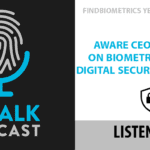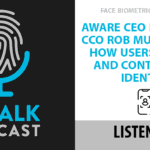
Having only been founded in 2016, ID R&D has enjoyed a rapidly rising profile in the biometrics industry over the last few years, with the company continuing to gain momentum over the course of 2019. The New York-based company kicked off the year by opening a new office in Silicon Valley, and it went on to raise $5.7 million in a series-A funding round in late spring. More recently, ID R&D President Alexey Khitrov joined the ranks of the Forbes Technology Council in late summer; and just a couple of weeks ago came the news that ID R&D’s solution proved to be the most accurate in the 2019 Automatic Speaker Verification Spoofing and Countermeasures (ASVspoof) Challenge.
Understandably, a few of these milestones entered into the discussion when FindBiometrics President Peter O’Neill recently had the opportunity to interview Khitrov. And the two also delved into some substantial issues in the biometrics industry, including the increasingly heated discussion around biometric surveillance and how that’s different from biometric authentication, and the importance of liveness detection in the latter; and Khitrov talked a little about how his company has been able to enhance the performance of its technology so rapidly (hint: part of the answer is in his company’s name).
Read the full interview with Alexey Khitrov, President, ID R&D:
Peter O’Neill, President, FindBiometrics: In terms of end users do you think consumers are getting more comfortable with biometric authentication or are there more serious obstacles we need to overcome?
Alexey Khitrov, Founder and President, ID R&D: I think there are a few layers to the story. We need to make a distinction between biometric surveillance and biometric authentication. The public is not at ease with biometric surveillance. People are uncomfortable with their images being captured in public places and used without their permission. And certainly, there is a lot of negative public perception around biometrics on this front.
But we don’t see similar discomfort or resistance from the public when it comes to biometric authentication, I think in part because the process is transparent and clear, and users can see what they’re agreeing to in terms of the use of their biometric data. Also, they are becoming increasingly accustomed to the convenience and sense of security that biometric authentication provides. The key to adoption here is the right balance between security and usability. We strongly believe that a frictionless user experience is the key to biometric adoption. Authentication is necessary and fortunately, we can remove much of the user effort within the authentication process without sacrificing security. ID R&D has been working on this for years, and it’s only because we’re committed to enhancing the core biometric science that we’ve been able to deliver.
So, we are developing a new generation of biometric technologies that improve security and strengthen the integrity of biometric authentication while minimizing or completely eliminating effort in the authentication process. We think that technology should provide the same experience that people have when they meet their friends or family. For example, when I see you at a conference I would say “Hello Peter” and you would immediately know it is me although I am not presenting my driver’s licence or answering some secret question that only you and I might know the answer to. We think customers should have a similar experience when they are communicating with their financial institutions, their healthcare providers, and the companies they deal with on a daily basis. ID R&D is committed to developing technologies that fuse biometric matching and biometric liveness in order to power comprehensive solutions that are both secure and effortless.
Peter O’Neill, President, FindBiometrics: At FindBiometrics and Mobile ID World we have been talking a lot lately about the importance of liveness detection. With your facial liveness detection solution are you finding that there is a growing awareness of the need for this kind of security in face authentication?
Alexey Khitrov, Founder and President, ID R&D: Absolutely. Liveness is becoming an integral part of biometric security. I think it is important to make a distinction between biometric matching and biometric security, because when we talk about security it is a much more comprehensive test that requires the answers to not one but to two questions. First is the biometric question: is this the right person? And the second is: is it a real person? Essentially, liveness detection provides integrity to biometric authentication by confirming the user’s physical presence and preventing bad guys from spoofing the system with facial images such as photos, cut outs, videos, or in the case of voice, with a recording or computer-generated speech.
The key here is the ability to provide technology that is both extremely secure and frictionless. Generally, the authentication process is seen by users as a necessary annoyance. Biometrics can remove the friction of passwords in the authentication process, but most of the liveness detection technologies re-introduce it. The vast majority of the systems to date rely on the active participation of the user and it is not a user-friendly experience when you are required to take additional action – to turn your head left or right or to move your phone in a certain way – simply to be identified…
What ID R&D did was introduce the first fully passive facial liveness capability. It can distinguish between a live person and a photo, cut out, mask, photo on a screen or a video of a person in front of the device. And it does so without requiring any extra steps or efforts from the end user.
So again, biometric authentication is best as a two-step process, asking first, “Is this the right person?” – which is biometric matching. And asking second, “Is this a live person” – which is biometric liveness. Unfortunately, in this day and age it is so easy to get access to somebody’s image. I can go to your website, Peter, and print a high-resolution photo in about 30 seconds. Without liveness, a facial recognition system could provide a positive biometric match (identifying your picture as Peter O’Neill) and grant access when in reality, it would be me holding that picture.
And passive liveness is absolutely crucial, we’ve seen a tremendous response to the facial liveness capability that ID R&D introduced to the market earlier this quarter.
We’ve also been working diligently on voice liveness and voice anti-spoofing which is an extremely important piece of the biometric portfolio. Voice biometrics are gaining wider acceptance and we are seeing a growing number of deployments across industries. Unfortunately, we are also seeing AI-driven capabilities that allow technology to mimic voices and build target voices that are indistinguishable from a live, human voice. Just a few weeks ago we saw the first publicized case where the fraudster built a target voice of an executive of an energy company. The fraudster used that computer-generated voice, posing as the executive, to call a company employee and direct them to transfer hundreds of thousands of dollars. Only after the money was gone did the company realize they’d been fooled by someone using synthetic voice.
So, text-to-speech or the computer-generated voice fraud is here and the threat is growing. The only way to fight it is with a voice biometric anti-spoofing capability. ID R&D has been working very hard on this capability for years and is uniquely able to deliver the technology. Just this week we announced that ID R&D was ranked first in the world’s largest performance benchmark evaluation designed specifically to measure the performance of anti-spoofing countermeasures against computer-generated speech, the LA ASVspoof 2019. New challenges are coming, and while bad actors will always try to exploit biometric systems with latest techniques, I’m confident that we’re equipped with the expertise and technological capabilities to stop them.
Peter O’Neill, President, FindBiometrics: With the latest upgrade of your IDVoice solution, you have attained speeds that are 10x faster than the previous version. How are you able to advance your technology so rapidly?
Alexey Khitrov, Founder and President, ID R&D: There are a number of things that allow us to move forward and constantly enhance our core biometric technology. First of all, we are true believers in continual investment in R&D and in the constant search for new and improved algorithms that deliver on both the security and usability of biometrics. That is where we concentrate our efforts.
Specific to IDVoice 2.7, there are two key developments that we see as important. First, the modified X-vector methodology that we use allows for significant enhancements in accuracy. With improved accuracy, the entire authentication experience is faster, seamless, and generally more user friendly. Our continued focus on constantly perfecting our algorithm allows us to rapidly bring these latest scientific breakthroughs into commercially available products. Second, our advanced data collection capabilities enable us to train on a large and diverse amount of labeled data. In fact, over the last number of years, we have collected one of the largest data sets specific to the development of voice biometrics.
To sum it up, our speed of innovation can be attributed to continuous advancements in R&D; our investment in collecting the right type of data at a large scale; and our core expertise in voice biometrics, signal processing, machine learning, and AI.
Peter O’Neill, President, FindBiometrics: You also expanded earlier this year into acoustic event detection, can you explain what this technology is and how it fits into your broader solutions portfolio?
Alexey Khitrov, Founder and President, ID R&D: Yes, we released our acoustic event detection solution IDAudio in March. This capability capitalizes on our expertise in audio processing and analysis, essentially enabling us to analyze audio streams and identify various types of sound events in real time, such as a baby crying, a dog barking, people sneezing or coughing, glass breaking, etc. Right now, we have 90 events in our portfolio and our portfolio is constantly growing.
We’re seeing growing demand for this technology especially in the IoT space. With smart homes, cameras can only cover a certain angle in a given space. By integrating our technology, any microphone-enabled device can detect noises outside of the cameras’ view, thereby providing additional security and monitoring capabilities to those types of devices.
By adding a sense of sound to smart home devices, the technology not only bolsters home security, but also provides peace-of-mind that hasn’t been widely available up until now. Once IDAudio is active, it’s constantly listening for these events and can provide instant alerts to end users – a critical new capability.
If we talk about the core technology itself here, we are capitalizing on the strengths of our R&D capabilities, our digital signal processing, and AI expertise.
Peter O’Neill, President, FindBiometrics: You recently joined the Forbes Technology Council. What does it mean for you and for ID R&D?
Alexey Khitrov, Founder and President, ID R&D: We are thrilled as this as an important invitation for us to share our voice, vision, and experience in regard to biometrics, security, and the user experience. Forbes is a fantastic global platform and we look forward to contributing to the conversations amongst the technology and business audiences there. We also hope to address some of those perceptions you mentioned and educate the public on the latest capabilities of biometric technologies and how they can transform security and user experience.
Peter O’Neill, President, FindBiometrics: You recently also raised $5.7 million through your Series A funding earlier this year. Does this reflect a growing market interest in AI or biometric technology generally? Tell us a little bit about this.
Alexey Khitrov, Founder and President, ID R&D: At ID R&D we have been working hard to develop core biometric and anti-spoofing technologies that are best-in-class and unique. And yes, the company has had a great start. Having built a significant customer base and have attracted strong interest from the investment community, we believe the timing is right to accelerate our growth. As biometric technology becomes a foundational component of a wider security strategy, and demand for frictionless user experiences increases, we are experiencing firsthand a shift from “let us learn about it” to “let us deploy it”. We just raised our Series A, which was oversubscribed, underscoring the interest in our technology from the investment community as it recognizes the importance of biometrics and our science-driven approach to enhancing core technologies to bring this frictionless experience to the market.








Follow Us